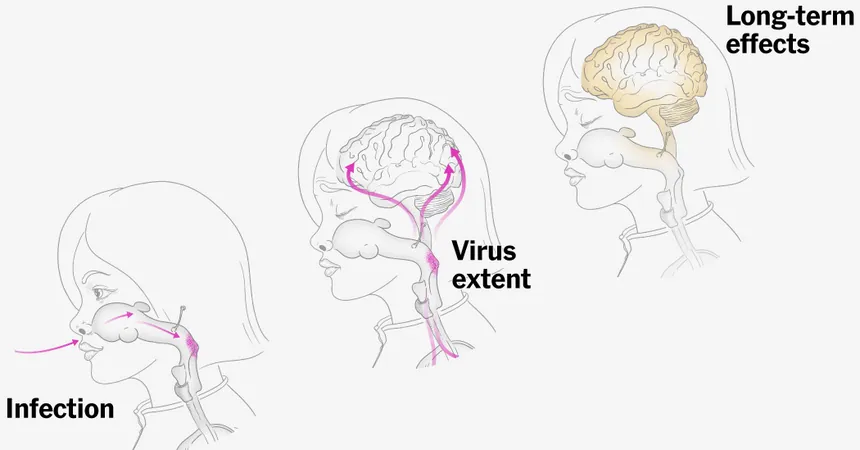
The Devastating Impact of Measles on Unvaccinated Children
2025-04-07
Author: Chun
Measles, one of the most contagious viruses known to humanity, poses a severe threat to unvaccinated children. In environments where they attend school, travel on buses, or even shop for groceries, no space is safe from potential exposure. Alarmingly, research shows that 9 out of 10 individuals who are not vaccinated and exposed to the virus will become infected. Once contracted, measles can wreak havoc on vital organs, including the lungs, kidneys, and brain.
With vaccination rates declining in the United States, health experts are warning of a potentially catastrophic rise in measles cases. Over 580 reported instances, including at least two deaths, have heightened concerns that thousands may be affected across the nation.
The transmission of measles is uniquely alarming; unlike many viruses that require close contact, the measles virus can linger in the air for up to two hours after an infected person has left a space. Children can unwittingly inhale virus-laden droplets in a classroom or playground, allowing the virus to enter through their nasal passages or mouth.
Once inside the body, the virus quickly begins its destructive path. It targets the nasopharynx cells in the upper throat, spreading to the lungs and rapidly multiplying to amass a formidable viral army for its assault. Within about a week, the infection spreads to lymphoid tissues and other organs throughout the body. In vaccinated children, the immune system would recognize and eliminate the virus at this stage, but unvaccinated children remain vulnerable.
As the virus proliferates, symptoms may not immediately manifest; the average incubation period is around two weeks, although it can range from just one to three weeks. However, once the viral load reaches critical levels, the child will start to feel unwell. Initially, children may experience mild symptoms, including malaise and fever, which can progress to reddened eyes, cough, and nasal congestion as the mucous membranes become inflamed.
A key indicator of measles is the appearance of small grayish-white bumps, known as Koplik spots, which can develop inside the cheeks. While these spots may be undetected by some, they serve as a warning sign of the disease's progression. Eventually, a red rash characteristic of measles will emerge, typically starting at the face and spreading downwards.
The rash can last up to a week and generally fades in the same order it appeared. However, a fever that persists beyond the third or fourth day following the rash is a red flag for potential complications, which could escalate the situation dramatically.
Even as the rash recedes, the infection continues to pose a threat, particularly to the lungs and other organs. Many children are hospitalized after sustaining the rash for several days, with health professionals noting significantly low oxygen levels and difficulty breathing. Dr. Summer Davies, who treats children at Covenant Children’s Hospital in Texas, reported families often bewildered by their child’s sudden decline in health after appearing fine just days earlier.
The initial mild illness can escalate into a high fever, reaching 104 to 105 degrees Fahrenheit, for several days. Other complications, such as poor hydration from sore throats and diarrhea, can lead to dehydration, further complicating the child’s condition and impacting kidney function.
Young children face the highest risks due to their developing bodies and inability to effectively communicate symptoms. Approximately 1 in 20 children with measles will experience pneumonia, with severe variants potentially leading to fatalities. Dr. Davies observed that many recent admissions involved pneumonia stemming from the measles virus or secondary infections that took hold as the immune systems faltered.
Tragically, the recent death of a 6-year-old girl in Texas highlights the stakes; she developed pneumonia after contracting measles, which ultimately hindered her breathing despite being sedated and intubated. Her case underscores the dangerous reality of measles complications that can evolve unexpectedly.
One critical consequence of measles is “immune amnesia,” which undermines a child’s immunity, leaving them more vulnerable to other infections for months or even years after recovery. Furthermore, around 1 in 1,000 children may develop encephalitis, causing potentially irreversible damage to the brain.
For infants or immunocompromised children, there is also a severe condition called measles inclusion body encephalitis (MIBE), which often leads to cognitive impairments and seizures, culminating in a high mortality rate. Another devastating long-term outcome could be subacute sclerosing panencephalitis (SSPE), a degenerative disease that may surface up to ten years post-infection, resulting in substantial behavioral changes, seizures, and eventual death, with survival rates plummeting to around 5%.
The heartbreaking experience of Erica Finkelstein-Parker, who lost her 8-year-old daughter Emmalee to SSPE, serves as a cautionary tale of the lingering effects of measles. Unbeknownst to Erica, Emmalee had previously contracted measles before her adoption from India. After displaying unusual symptoms, such as tripping and difficulty maintaining posture, doctors ultimately revealed there was no remedy available; Emmalee succumbed to the condition just five months later.
This painful reminder reinforces the urgency of vaccination and the critical need to protect children from measles and its potentially life-altering consequences.




 Brasil (PT)
Brasil (PT)
 Canada (EN)
Canada (EN)
 Chile (ES)
Chile (ES)
 Česko (CS)
Česko (CS)
 대한민국 (KO)
대한민국 (KO)
 España (ES)
España (ES)
 France (FR)
France (FR)
 Hong Kong (EN)
Hong Kong (EN)
 Italia (IT)
Italia (IT)
 日本 (JA)
日本 (JA)
 Magyarország (HU)
Magyarország (HU)
 Norge (NO)
Norge (NO)
 Polska (PL)
Polska (PL)
 Schweiz (DE)
Schweiz (DE)
 Singapore (EN)
Singapore (EN)
 Sverige (SV)
Sverige (SV)
 Suomi (FI)
Suomi (FI)
 Türkiye (TR)
Türkiye (TR)
 الإمارات العربية المتحدة (AR)
الإمارات العربية المتحدة (AR)